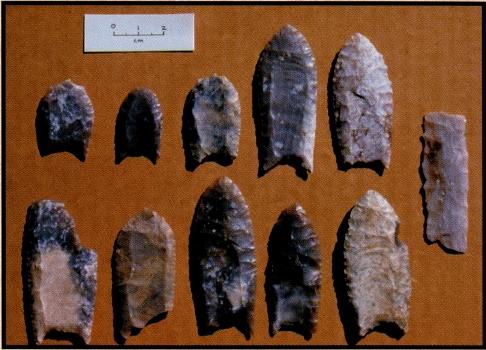By Ruthann Knudson, Ph.D.
When is a Folsom point just that and not an unfluted Folsom or a Midland point? A clue to this classificatory question lies in the Lipscomb Folsom site and assemblage.

The Lipscomb site in the northeast corner of the Texas Panhandle (Fig. 1) was known by World War I, excavated by C. Bertrand Schultz of the University of Nebraska State Museum in 1939 (Schultz 1943) and 1946, and then reinvestigated by Jack Hofman and Lawrence Todd in 1988-1993 (Hofman 1999; Todd, Hofman, and Schultz 1993). The site has never been characterized as anything but a Folsom site.
Figure 2.

Folsom hunters killed and butchered at least 56 bison at Lipscomb, probably in the late summer or early fall. A total of 30 flaked stone projectile points (Figs. 2-4) and fragments were found at the site, as well as 13 other flaked stone tools (Fig. 5), two channel flakes (Fig. 2), and more than 20 small flakes. Most of the flakes probably are from resharpening and reworking the flaked stone tools.
Figure 3.

Almost all of the projectile points found at Lipscomb have had “flutes” removed from both faces of the point, e.g., flakes taken off the longitudinal axes of each face to leave concave grooves on those faces. But one Edwards Plateau chert point (Fig. 4a) had only one flute removed, with the other face still bearing the smooth face of the tool’s original flake perform. A second point, which may also be Edwards Plateau chert (Fig. 4b), also has a remnant of its original preform face across which a flute has been removed. The archetypical Folsom point, the point found between bison ribs at the original Folsom site, also has a remnant of its original preform flake face at the top of its flute scar. These original flake faces are oriented with the platforms from which they were struck (presumably the thickest part of the original flake) of the finished tool. Thus, the thinner part of the original preform flake would have been used to shape the proximal or hafted end of the point.
Figure 4.

There are several large bifacial flake tools in the Lipscomb assemblage (Fig. 5) that would have been useful butchering tools as well as preforms for new Folsom points when needed. This idea is discussed by Ingbar and Hofman (1999:103) in their analysis of the Lipscomb tool kit—this paper is a good read for anyone interested in Folsom technology.
Figure 5.

“Unfluted” points within Folsom assemblages are not unusual. Ingbar and Hofman (1999:102) noted that they have been found at Blackwater Draw (34%) and Elida (16%) in New Mexico, Lindenmeier (25%) in Colorado, and Hanson (10%) in Wyoming Unfluted points showing their original flake preform faces are also found at the Plainview site (Knudson 2005) in the Texas Panhandle. The Plainview site and related materials are generally dated at 10,000 radiocarbon years ago, some 600 years later than most of the Folsom material. I have called this use of direct thin flake manufacture of stone points the Sudplano (sud = southern, Figure 5 piano = plains) technology, and it is exhibited in at least the Folsom, Midland, Milnesand, Jurgens, Olsen-Chubbuck, Lubbock Lake, Lindenmeier Folsom, and Bonfire Shelter assemblages as well as at Lipscomb (Knudson 1998:653). This technology seems to have been very useful and to have lasted quite a while!
The Lipscomb Folsom site, its bones, and its flaked stone tools have been known for at least 80 years, but there are always new ideas and information from such a classic site and collection. It is always fun going back to the early finds.